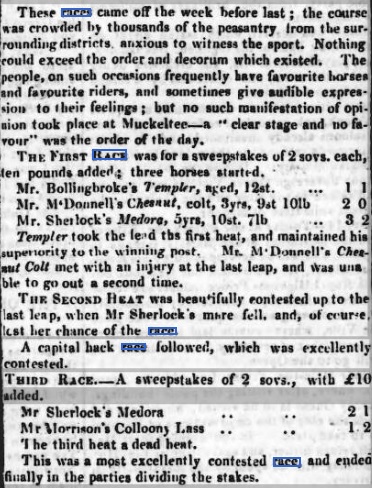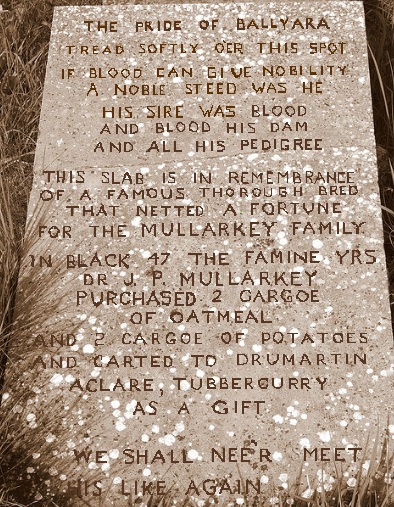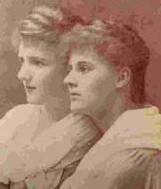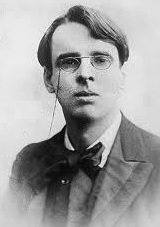Earliest meeting: Thursday 14th September 1843
Final meeting: Friday 9th October 1908
The town of Tubbercurry, also known as Tobercurry, is the second largest town in County Sligo and had its own racecourse in the 19th century. The course was situated on Maxwell’s Farm in Rhue. It was a family concern but its isolated location made it a challenge for the horses, owners and trainers to travel to the track. On the outskirts of the farm is Ballyara’s Old Cemetery and the remains of Pride of Ballyara are buried in the Mullarkey family plot. The racehorse Pride of Ballyara was owned by Dr Joe Mullarkey and won many races, including a Gold Cup (not the Cheltenham one), in England. It was the time of the great Irish Famine and the philanthropic family used their winnings to purchase food for the inhabitants of Tubbercurry to prevent their starvation. Pride of Ballyara retired from racing in 1845 and went on to pull food carts loaded with grain on 50 mile round trips. Such was the high esteem in which the family held him that they used part of the family plot to bury him. Meetings continued at the track until a final card was staged on Friday 9th October 1908.
Thursday 14th September 1843 from the Sligo Champion of Saturday 23rd September 1843

On the outskirts of the farm is Ballyara’s Old Cemetery and the remains of Pride of Ballyara are buried in the Mullarkey family plot. Pride of Ballyara was owned by Dr Joe Mullarkey and won many races, including a Gold Cup (not the Cheltenham one), in England. It was the time of the great Irish Famine and the philanthropic family used their winnings to purchase food for the inhabitants of Tubbercurry to prevent their starvation. Pride of Ballyara retired from racing in 1845 and went on to pull food carts loaded with grain on 50 mile round trips. Such was the high esteem in which the family held him that they used part of the family plot to bury him.


Constance Markievicz was born Constance Gore-Booth on 4th February 1868 at Buckingham Gate in London. She was the daughter of Sir Henry Gore-Booth, the 5th Baronet, who owned Lissadell House (shown opposite) ; a Greek style Country House, near Tubbercurry in County Sligo, and this is where Constance spent her childhood years. She later became a prominent suffragette and in December 1918 she was the first woman to be elected to the British House of Commons.
Eva Selina Laura Gore-Booth was born on 22nd May 1870 at Lissadell House where she spent her childhood. She established the Sligo branch of the Irish Women’s Suffrage Association and shortly after this she moved to Manchester. She became a suffragette and a Poet and died in 1926 at Hampstead, London.

The two sisters were great friends of William Butler Yeats (show opposite) during their early years as they grew up around Tubbercurry. W B Yeats was born in Dublin on 13th June 1865, but spent most of his early life living near Tubbercurry and is likely to have attended Tubbercurry Racecourse, possibly in the company of the Gore-Booth sisters. He later marked his friendship with the poem ‘In Memory of Eva Gore-Booth and Constance Markiewicz’.

Shane and Kathleen Richardson (nee Maxwell) took over Maxwell's farm in Rhue in 1948 and it was well known in the early 20th century as the venue of Tubbercurry Racecourse as there was a dedicated track and grandstand there over many decades. During that time the business and professional community of Co. Sligo were very involved in the horse racing sport and the Rhue Racecourse on Maxwell’s farm was a venue of many a great race and gamble. After Shane took over the Maxwell farm he enjoyed recounting many of the stories and hearsay events of that period to his family and close friends.
The links between Tubbercurry and racing continued, but in the form of Greyhound Racing, when Tubbercurry Lad was a star in the mid-1980's.
In 1984 he reached the 2nd Round of the English Greyhound Derby, being beaten into 4th place behind the eventual winner Whisper Wishes. However, he did reach the Irish Greyhound Derby Final in that year, finishing 5th behind Dipmac. Greyhound Derby 1984
In 1985 Tubbercurry Lad did not contest the English Greyhound Derby and this paid dividends because he was fresh for the Irish equivalent. He won the Irish Greyhound Derby, beating Manorville Sand in a time of 29.14. Greyhound Derby 1985
Whilst there is little evidence of the old racecourse today, the Water Jump does still remain and marks the place where a jockey was killed at one of the 19th Century meetings.
Much of the information about this course has been found using internet research and is in the public domain. However, useful research sources have been:-
London Illustrated News
Racing Illustrated 1895-1899
The Sporting & Dramatic Illustrated
Northern Turf History Volumes 1-4 by J.Fairfax-Blakeborough
The Sporting Magazine
A Long Time Gone by Chris Pitt first published in 1996 ISBN 0 900599 89 8
Racing Calendars which were first published in 1727



